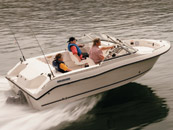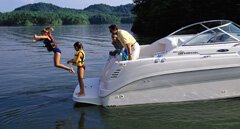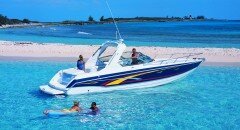How to prepare your boat for a hurricane.
By Capt. Vincent Daniello
Unfortunately, I’ve had too much experience with hurricanes. The 2004 season started when Hurricane Charley’s 150 mph winds battered my wife’s grandparents’ home in Pine Island, Florida. Weeks later I was securing clients’ boats ahead of Hurricanes Frances and Jeanne. In 2005, I moved to Miami in time for Katrina, Rita and Wilma. Add Hurricanes Isabel in Washington, D.C. in 2003, Floyd in the Bahamas in 1999, Bob in North Carolina in 1991 and many more. I took away valuable lessons from each.
Of the three damaging elements of hurricanes — wind, rain and storm surge — wind is the most underestimated. Windage increases by the square of the wind velocity. Five square yards of flat surface generate about 10 pounds of pressure in a 10-knot breeze. At 30 knots, the same five yards create 90 pounds of force and at 100 knots, 1,000 pounds. With that much force, surviving 120 mph winds or more — a direct hit from a solid category-three hurricane — is as much about luck as preparation. But avoiding damage in a glancing blow or lesser storm is likely with proper preparation. "The area of serious destruction is pretty small," says Frank Atlass, CEO of South Florida-based Atlass Insurance Group. "If you’re within a mile or so of the eye, you’re going to have a lot of damage. But if the winds stay under 120 mph, it’s possible to survive without too much damage."
Atlass’ experiences with customers’ claims back up my three-part philosophy:
- Prepare well for a near-miss;
- assemble and check all gear at the beginning of the season;
- and keep preparations, and later dismantling, as simple and quick as possible.
Once a major hurricane is imminent, there are (or should be) far bigger concerns than the boat.
Consider my suggestions as an overall strategy. Each boat, dock and storm is unique and requires different tactics. For example, if a minor storm with lots of rain is forecast, I’ll leave shore power connected to keep batteries charged. But if a major blow is coming, I’ll disconnect power cords and run a portable battery charger using a heavy-duty extension cord from the dock. (Running the generator is another option, but storm debris will likely clog sea strainers.)
Take photos of your preparations and those of neighboring boats before the storm. (Film is easier than digital to prove authentic in court.) It’s also wise to have tarps, tie wraps and duct tape handy to mitigate additional damage after the storm, but be careful when returning to the boat. Hurricanes cause broken planks with protruding nails and live, exposed electrical wires. I’ve also run into confused and displaced spiders and snakes.
Most importantly, never risk life or limb. "We don’t want anyone to get hurt," Atlass says. At some point boat owners should say: "I’ve done my best. It may not be good enough, but it might be. I’ve got other possessions to tend to, and my family, which is most important."
After witnessing so many hurricanes’ destructive powers, I couldn’t agree more.
Dry Stack
While many insurance companies will pay to have boats hauled, dry stack storage facilities often aren’t built to withstand hurricane winds. A few facilities are, however, and may earn you reduced insurance premiums as well as save your boat.
Boat Lifts
Boat lifts are not a sure bet, either. If your lift seems like the safest option, raise the boat high, above storm surge. To keep the boat and lift from moving, secure the boat to the lift and tie both to the dock. Then raise the lift a few inches to cinch everything tight.
Canvas Cover
Removing canvas reduces windage, and most insurance companies will pay only a depreciated value for damaged canvas. On the other hand, bridge enclosures protect electronics in a near-miss with perhaps only 30 or 40 knots of wind but hours or days of torrential rain. I’d rather repair or replace canvas than worry about soggy electronics that might fail weeks or months later while offshore. Either way, tape covers down and even add a tarp to protect electronics from water. Duct tape is secure but will leave a mess. Painters’ tape is easier to remove. Plastic shrink-wrap tape is strongest and fairly easy to clean, but hard to find on short notice.
Dry Box
Both setting and stowing hurricane lines is much quicker when everything is assembled in one place ahead of time.
Chain Piling
Chain and thimbles are the best guarantee against chafing, particularly on concrete pilings. A fire hose will protect pilings from the chain. This rig will slide up and down most fixed pilings that hold floating docks in place, too. Tie wraps prevent shackle pins from unscrewing, and they are easy to remove later.
Shared with Permission from MotorBoating.


